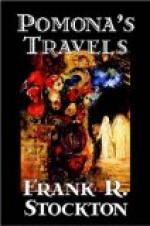There was no doubt about the old man’s being right about the crookedness of the stream. If you have ever noticed an ant running over the floor you will have an idea how the Wye runs through this beautiful country. If it comes to a hill it doesn’t just pass it and let you see one side of it, but it goes as far around it as it can, and then goes back again, and goes around some other hill or great rocky point, or a clump of woods, or anything else that travellers might like to see. At one place, called Symond’s Yat, it makes a curve so great, that if we was to get out of our boat and walk across the land, we would have to walk less than half a mile before we came to the river again; but to row around the curve as we did, we had to go five miles.
Every now and then we came to rapids. I didn’t count them, but I think there must have been about one to every mile, where the river-bed was full of rocks, and where the water rushed furiously around and over them. If we had been rowing ourselves we would have gone on shore and camped when we came to the first of these rapids, for we wouldn’t have supposed our little boat could go through those tumbling, rushing waters; but old Samivel knew exactly how the narrow channel, just deep enough sometimes for our boat to float without bumping the bottom, runs and twists itself among the hidden rocks, and he’d stand up in the bow and push the boat this way and that until it slid into the quiet water again, and he sat down to his oars. After we had been through four or five of these we didn’t feel any more afraid than if we had been sitting together on our own little back porch.
As for the banks of this river, they got more and more beautiful as we went on. There was high hills with some castles, woods and crags and grassy slopes, and now and then a lordly mansion or two, and great massive, rocky walls, bedecked with vines and moss, rising high up above our heads and shutting us out from the world.
Jone and I was filled as full as our minds could hold with the romantic loveliness of the river and its banks, and old Samivel was so pleased to see how we liked it—for I believe he looked upon that river as his private property—that he told us about everything we saw, and pointed out a lot of things we wouldn’t have noticed if it hadn’t been for him, as if he had been a man explaining a panorama, and pointing out with a stick the notable spots as the canvas unrolled.
The only thing in his show which didn’t satisfy him was two very fine houses which had both of them belonged to noble personages in days gone by, but which had been sold, one to a man who had made his money in tea, and the other to a man who had made money in cotton. “Think of that,” said he; “cotton and tea, and living in such mansions as them are, once owned by lords. They are both good men, and gives a great deal to the poor, and does all they can for the country; but only think of it, madam, cotton and tea! But all that happened a good while ago, and the world is getting too enlightened now for such estates as them are to come to cotton and tea.”




